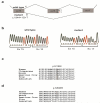Recessive mutations of TMC1 associated with moderate to severe hearing loss
- PMID: 26879195
- PMCID: PMC4795972
- DOI: 10.1007/s10048-016-0477-1
Recessive mutations of TMC1 associated with moderate to severe hearing loss
Abstract
TMC1 encodes a protein required for the normal function of mechanically activated channels that enable sensory transduction in auditory and vestibular hair cells. TMC1 protein is localized at the tips of the hair cell stereocilia, the site of conventional mechanotransduction. In many populations, loss-of-function recessive mutations of TMC1 are associated with profound deafness across all frequencies tested. In six families reported here, variable moderate-to-severe or moderate-to-profound hearing loss co-segregated with STR (short tandem repeats) markers at the TMC1 locus DFNB7/11. Massively parallel and Sanger sequencing of genomic DNA revealed each family co-segregating hearing loss with a homozygous TMC1 mutation: two reported mutations (p.R34X and p.R389Q) and three novel mutations (p.S596R, p.N199I, and c.1404 + 1G > T). TMC1 cDNA sequence from affected subjects homozygous for the donor splice site transversion c.1404 + 1G > T revealed skipping of exon 16, deleting 60 amino acids from the TMC1 protein. Since the mutations in our study cause less than profound hearing loss, we speculate that there is hypo-functional TMC1 mechanotransduction channel activity and that other even less damaging variants of TMC1 may be associated with more common mild-to-severe sensorineural hearing loss.
Keywords: DFNB7/11; Mechanosensory transduction; Moderate or severe hearing loss; TMC1.
Figures


Similar articles
-
A novel DFNA36 mutation in TMC1 orthologous to the Beethoven (Bth) mouse associated with autosomal dominant hearing loss in a Chinese family.PLoS One. 2014 May 14;9(5):e97064. doi: 10.1371/journal.pone.0097064. eCollection 2014. PLoS One. 2014. PMID: 24827932 Free PMC article.
-
Mutation analysis of TMC1 identifies four new mutations and suggests an additional deafness gene at loci DFNA36 and DFNB7/11.Clin Genet. 2008 Sep;74(3):223-32. doi: 10.1111/j.1399-0004.2008.01053.x. Epub 2008 Jul 9. Clin Genet. 2008. PMID: 18616530 Free PMC article.
-
Progressive sensorineural hearing loss and normal vestibular function in a Dutch DFNB7/11 family with a novel mutation in TMC1.Audiol Neurootol. 2011;16(2):93-105. doi: 10.1159/000313282. Epub 2010 Jun 26. Audiol Neurootol. 2011. PMID: 21252500
-
Is TMC1 the Hair Cell Mechanotransducer Channel?Biophys J. 2016 Jul 12;111(1):3-9. doi: 10.1016/j.bpj.2016.05.032. Biophys J. 2016. PMID: 27410728 Free PMC article. Review.
-
Autosomal recessive non-syndromic hearing loss genes in Pakistan during the previous three decades.J Cell Mol Med. 2024 Apr;28(8):e18119. doi: 10.1111/jcmm.18119. J Cell Mol Med. 2024. PMID: 38534090 Free PMC article. Review.
Cited by
-
Using Drosophila to study mechanisms of hereditary hearing loss.Dis Model Mech. 2018 May 31;11(6):dmm031492. doi: 10.1242/dmm.031492. Dis Model Mech. 2018. PMID: 29853544 Free PMC article. Review.
-
ELMOD3, a novel causative gene, associated with human autosomal dominant nonsyndromic and progressive hearing loss.Hum Genet. 2018 Apr;137(4):329-342. doi: 10.1007/s00439-018-1885-0. Epub 2018 Apr 30. Hum Genet. 2018. PMID: 29713870
-
Emerging Gene Therapies for Genetic Hearing Loss.J Assoc Res Otolaryngol. 2017 Oct;18(5):649-670. doi: 10.1007/s10162-017-0634-8. Epub 2017 Aug 16. J Assoc Res Otolaryngol. 2017. PMID: 28815315 Free PMC article. Review.
-
Improved TMC1 gene therapy restores hearing and balance in mice with genetic inner ear disorders.Nat Commun. 2019 Jan 22;10(1):236. doi: 10.1038/s41467-018-08264-w. Nat Commun. 2019. PMID: 30670701 Free PMC article.
-
Molecular genetic landscape of hereditary hearing loss in Pakistan.Hum Genet. 2022 Apr;141(3-4):633-648. doi: 10.1007/s00439-021-02320-0. Epub 2021 Jul 25. Hum Genet. 2022. PMID: 34308486 Review.
References
-
- Kitajiri SI, McNamara R, Makishima T, Husnain T, Zafar AU, Kittles RA, Ahmed ZM, Friedman TB, Riazuddin S, Griffith AJ. Identities, frequencies and origins of TMC1 mutations causing DFNB7/B11 deafness in Pakistan. Clin Genet. 2007;72:546–550. - PubMed
-
- Kurima K, Peters LM, Yang Y, Riazuddin S, Ahmed ZM, Naz S, Arnaud D, Drury S, Mo J, Makishima T, Ghosh M, Menon PS, Deshmukh D, Oddoux C, Ostrer H, Khan S, Riazuddin S, Deininger PL, Hampton LL, Sullivan SL, Battey JF, Jr, Keats BJ, Wilcox ER, Friedman TB, Griffith AJ. Dominant and recessive deafness caused by mutations of a novel gene, TMC1, required for cochlear hair-cell function. Nat Genet. 2002;30:277–284. - PubMed
-
- Makishima T, Kurima K, Brewer CC, Griffith AJ. Early onset and rapid progression of dominant nonsyndromic DFNA36 hearing loss. Otol Neurotol. 2004;25:714–719. - PubMed
-
- Vreugde S, Erven A, Kros CJ, Marcotti W, Fuchs H, Kurima K, Wilcox ER, Friedman TB, Griffith AJ, Balling R, Hrabé De Angelis M, Avraham KB, Steel KP. Beethoven, a mouse model for dominant, progressive hearing loss DFNA36. Nat Genet. 2002;30:257–258. - PubMed
-
- Keats BJ, Nouri N, Huang JM, Money M, Webster DB, Berlin CI. The deafness locus (dn) maps to mouse chromosome 19. Mamm Genome. 1995:8–10. - PubMed
Publication types
MeSH terms
Substances
Grants and funding
LinkOut - more resources
Full Text Sources
Other Literature Sources

